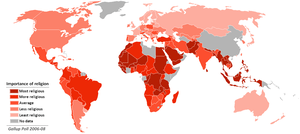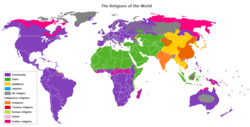بڑے مذہبی گروہ
دنیا کے بڑے مذاہب اور روحانی عقائد کو ایک چھوٹی تعداد میں بڑے گروہوں میں درجہ بندی کر سکتے ہیں۔ یہ نظریہ معاشروں میں نسبتا تہذیب کی سطح کو تسلیم کرنے کے مقصد کے ساتھ اٹھارویں صدی میں شروع ہوا۔
بڑے مذاہب
| مذہبی زمرہ | تعداد پیروکار (ملین) | ثقافتی روایت | قیام | حوالہ جات |
|---|---|---|---|---|
| مسیحیت | 2,000–2,200 | ابراہیمی ادیان | سرزمین شام, پہلی صدی | [2] |
| اسلام | 1,570–1,650 | ابراہیمی ادیان | جزیرہ نما عرب | [3][4][5] |
| ہندو مت | 828–1,000 | دھرمی ادیان | ہندوستان | [6] |
| بدھ مت | 400–500 | دھرمی ادیان | ہندوستان، چوتھی صدی ق م | [7][8][9] |
| لوک مذہب | سینکڑوں | لوک مذہب | دنیا بھر | [nb 1] |
| چینی لوک مذہب (بشمول تاؤ مت اور کنفیوشس مت) | سینکڑوں | چینی مذاہب | چین | [nb 1] |
| شنتومت | 27–65 | جاپانی مذاہب | جاپان | [10] |
| سکھ مت | 24–28 | دھرمی ادیان | ہندوستان | [7][11] |
| یہودیت | 14–18 | ابراہیمی ادیان | سرزمین شام | [7] |
| جین مت | 8–12 | دھرمی ادیان | ہندوستان، نویں صدی ق م | [nb 2] |
| بہائیت | 7.6–7.9 | ابراہیمی ادیان | ایران، انیسویں صدی | [12][13][nb 3] |
| کائو دای | 1–3 | ويتنامی مذاہب | ويتنام، بیسویں صدی | [14] |
| چینڈو مت | 3 | کوریائی مذاہب | کوریا، انیسویں صدی | [15] |
| تنریکیو | 2 | جاپانی مذاہب | جاپان, انیسویں صدی | [16] |
| ویکا | 1 | نئی مذہبی تحریک | برطانیہ، بیسویں صدی | [17] |
| مسیحی کلیسیا عالم | 1 | جاپانی مذاہب | جاپان، بیسویں صدی | [18] |
| سائیکو-نو-ائی | 0.8 | جاپانی مذاہب | جاپان، بیسویں صدی | [16] |
| راستافاريہ تحریک | 0.7 | نئی مذہبی تحریک، ابراہیمی ادیان | جمیکا، بیسویں صدی | [19] |
| عالمگیری موحدين | 0.63 | نئی مذہبی تحریک | ریاست ہائے متحدہ امریکا، بیسویں صدی | [20] |
درمیانے درجے کے مذاہب
| مذہبی زمرہ | تعداد پیروکار | ثقافتی روایت | قیام | حوالہ جات |
|---|---|---|---|---|
| ساینتولوجی | 500,000 | نئی مذہبی تحریک | ریاست ہائے متحدہ امریکا، 1953 | [21][21] |
| زرتشت | 150,000 - 200,000 | ایرانی مذہب | ایران، دسویں - پندھرویں ڈسی ق م | [22] |
| اکانکر | 50,000 - 500,000 | نئی مذہبی تحریک | ریاست ہائے متحد، 1973 | [23] |
| شیطان پرستی | 30,000 - 100,000 | نئی مذہبی تحریک | ریاست ہائے متحد،, 1966 | [24] |
| رائلیانیت | 80,000 - 85,000 | یو ایف او مذہب | فرانس، 1974 | [25][26] |
| درويدیت | 50,000 | جدید بت پرستی | برطانیہ، اتھارویں صدی | [27] |
نقشہ جات خود روداد وابستگی
|
مزید دیکھیے
حوالہ جات
- "The Global Religious Landscape"۔ The Pew Forum on Religion & Public Life۔ Pew Research center۔ 18 دسمبر 2012۔ مورخہ 25 دسمبر 2018 کو اصل سے آرکائیو شدہ۔ اخذ شدہ بتاریخ 18 مارچ 2013۔
- World Christian Database گورڈن–کونویل تھیولاجیکل سیمینری Centre for the Study of Global Christianity
-
Tracy Miller (ویکی نویس.)۔ Mapping the Global Muslim Population: A Report on the Size and Distribution of the World’s Muslim Population۔ پیو ریسرچ سینٹر۔ مورخہ 25 دسمبر 2018 کو اصل (PDF) سے آرکائیو شدہ۔ اخذ شدہ بتاریخ 2009-10-08۔ Unknown parameter
|month=ignored (معاونت) - "The World Factbook"۔ CIA Factbook۔ مورخہ 6 جنوری 2019 کو اصل سے آرکائیو شدہ۔ اخذ شدہ بتاریخ 2010-12-08۔
- 2010 World Muslim Population pdf Dr. Houssain Kettani January 2010
- Clarke, Peter B. (editor), The Religions of the World: Understanding the Living Faiths, Marshall Editions Limited: USA (1993); pg. 125
- "World". کتاب حقائق عالم, 2010
- Fischer-Schreiber, Ingrid, et al. The Encyclopedia of Eastern Philosophy & Religion: Buddhism, Hinduism, Taoism, Zen. Shambhala: Boston (English: pub. 1994; orig. German: 1986); pg. 50.
- a BBC News article
- Japanese government
- Indian Registrar General & Census Commissioner. "Religious Composition". بھارت میں مردم شماری, 2001
- "World Religions (2005)"۔ QuickLists> The World> Religions۔ The Association of Religion Data Archives۔ مورخہ 25 دسمبر 2018 کو اصل سے آرکائیو شدہ۔ اخذ شدہ بتاریخ 2009-07-04۔
- "World: People: Religions"۔ کتاب حقائق عالم۔ سی آئی اے۔ ISSN 1553-8133۔ مورخہ 25 دسمبر 2018 کو اصل سے آرکائیو شدہ۔ اخذ شدہ بتاریخ 2009-09-06۔
- Sergei Blagov. "Caodaism in Vietnam : Religion vs Restrictions and Persecution". IARF World Congress, Vancouver, Canada, July 31st, 1999.
- Self-reported figures from 1999; North Korea only (South Korean followers are minimal according to self-reported figures). In The A to Z of نئی مذہبی تحریکs by George D. Chryssides. ISBN 0-8108-5588-7
- Self-reported figures printed in Japanese Ministry of Education's 宗教年間 Shuukyou Nenkan, 2003
- Encyclopedia of the Modern Middle East and North Africa (Detroit: Thompson Gale, 2004) p. 82
- Clarke, Peter B. (editor), The Religions of the World: Understanding the Living Faiths, Marshall Editions Limited: USA (1993); pg. 208. "Sekai Kyuseikyo has about one million members, a growing number of them in the west and the third world, especially Brazil and Thailand. "
- Leonard E. Barrett. The Rastafarians: Sounds of Cultural Dissonance. Beacon Press, 1988. p. viii.
- American Religious Identification Survey
- Major religions ranked by size retrieved 11 November 2012
- Zoroastrianism religionfacts retrieved 11 November 2012
- The big religion chart retrieved 11 November 2012
- The Devil's Party: Satanism in Modernity - Page 5, Per Faxneld, Jesper Aa. Petersen - 2013
- Rael Press retrieved 12 November 2012
- Introduction to New and Alternative Religions in America: African diaspora traditions and other American innovations, Eugene V. Gallagher, W. Michael Ashcraft - 2006
- The Everything Paganism Book, Selene Silverwind - 2011
ملاحظات
- The number of people who consider themselves party to a "folk tradition" is impossible to determine.
- Figures for the population of Jains differ from just over six million to twelve million due to difficulties of Jain identity, with Jains in some areas counted as a Hindu sect. Many Jains do not return Jainism as their religion on census forms for various reasons such as certain Jain castes considering themselves both Hindu and Jain. Following a major advertising campaign urging Jains to register as such, the 1981 Census of India returned 3.19 million Jains. This was estimated at the time to still be half the true number. The 2001 Census of India had 8.4 million Jains.
- Historically, the Bahá'í Faith arose in 19th century Persia, in the context of اہل تشیع، and thus may be classed on this basis as a divergent strand of Islam, placing it in the Abrahamic tradition. However, the Bahá'í Faith considers itself an independent religious tradition, which draws from Islam but also other traditions. The Bahá'í Faith may also be classed as a نئی مذہبی تحریک، due to its comparatively recent origin, or may be considered sufficiently old and established for such classification to not be applicable.
This article is issued from
Wikipedia.
The text is licensed under Creative
Commons - Attribution - Sharealike.
Additional terms may apply for the media files.





